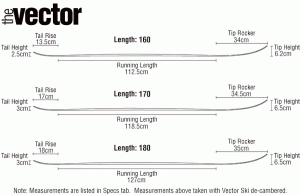First Impressions
Conditions were suspect for my maiden voyage on Voile’s Vector ski with their Switchback X2 binding. Nonetheless they delivered admirable performance. A good six inches of heavy snow had fallen a day earlier. The skies cleared the night before and temperatures dropped into the single digits (F) causing the surface to dry out a bit, but not enough to overcome a temperature crust that had begun to form already. Thus, the goods were encased in a heinous breakable crust that was enough to almost hold my weight, but not quite.On the climb up I broke through the crust every step of the way so I wasn’t anticipating a glorious descent. The early rise tip of the Vector definitely helped while breaking trail to prevent my skis from submarining and they easily rose to the surface. On subsequent tours in light and heavy powder, this feature of the Vector’s performance remained consistent.
The semi-twin tip tail was acceptable, but it did require me to be more careful when jamming the tail of my ski under the other on a kick turn. Just one of the reasons I’m not a fan of twin tips. As twin-tips go, while not laudable, this one is bearable.
The descent was far better than expected. At 94mm underfoot, the Vector is considered a mid-fat ski by modern standards. Personally I’m not too inclined to accept continual revision of terms and a mid-fat for this curmudgeon is still in the 80-88mm range. So I’ll buck the popular trend and call it what it is, a fat ski. Fat enough to give more flotation than a mid-fat, and fat enough to make difficult conditions easier to ski, but no so fat that it weighs you down with all the extra weight that comes with girth. Most importantly it was fat enough that I floated pretty well on the breakable crust, but not so fat that I didn’t break through.
Fortunately, nearly 23 years of telemark experience plus a pair of T2Xs bound to the Vectors with Voile’s new Switchback X2, a Switchback on steroids, gave enough power to stay in control the whole way down. The early rise tip on the Vectors didn’t hurt either. Though I embraced the fall line, thankfully, I didn’t fall, not even once.
Since then I’ve done a few more tours and must say this is one of the more aggressive early rise tips, especially for a fat ski that doesn’t tip the scales with too much weight or width. On champagne powder days the early rise tip gives the Vector as much flotation as skis that are 100mm at the waist. However, this early rise tip also makes the Vector turn like a much shorter ski. In fact, it felt so much shorter that I questioned my mounting point which was only 1cm forward of the mid-boot point.
Voile recommends using mid-boot as the point of reference for mounting, but it seemed like even with the early rise tip the Vector was diving in light powder easier than it should. So I moved it back to 1cm behind the mid-boot point, a mere 2cm difference to the rear. This was a noticeable difference, but not dramatic. After more than 15 years testing telemark skis it became standard procedure to mount telemark bindings at chord center or a few centimeters forward. The Vector, with a dramatic early rise tip bucks that trend. I need to move the bindings back one more time and compare before making any conclusions.
I can say it handles crud and chopped up junk great, and though it can hold an edge on firm snow, my RT-86’s do a better job on hard and icy snow with a lower power binding.
If you are still relying predominantly on skis with a waist width in the 80s, the Vector is the perfect fat ski to round out your quiver with some extra girth when the snow is extra deep without giving in to the temptation of obese skis.
WildSnow view of Voile’s Vector here.
© 2011



1 ping
[…] Posts Vector BC review Fischer S-Bound 112 review Share this:PrintEmailShareStumbleUponDiggRedditpinterest […]